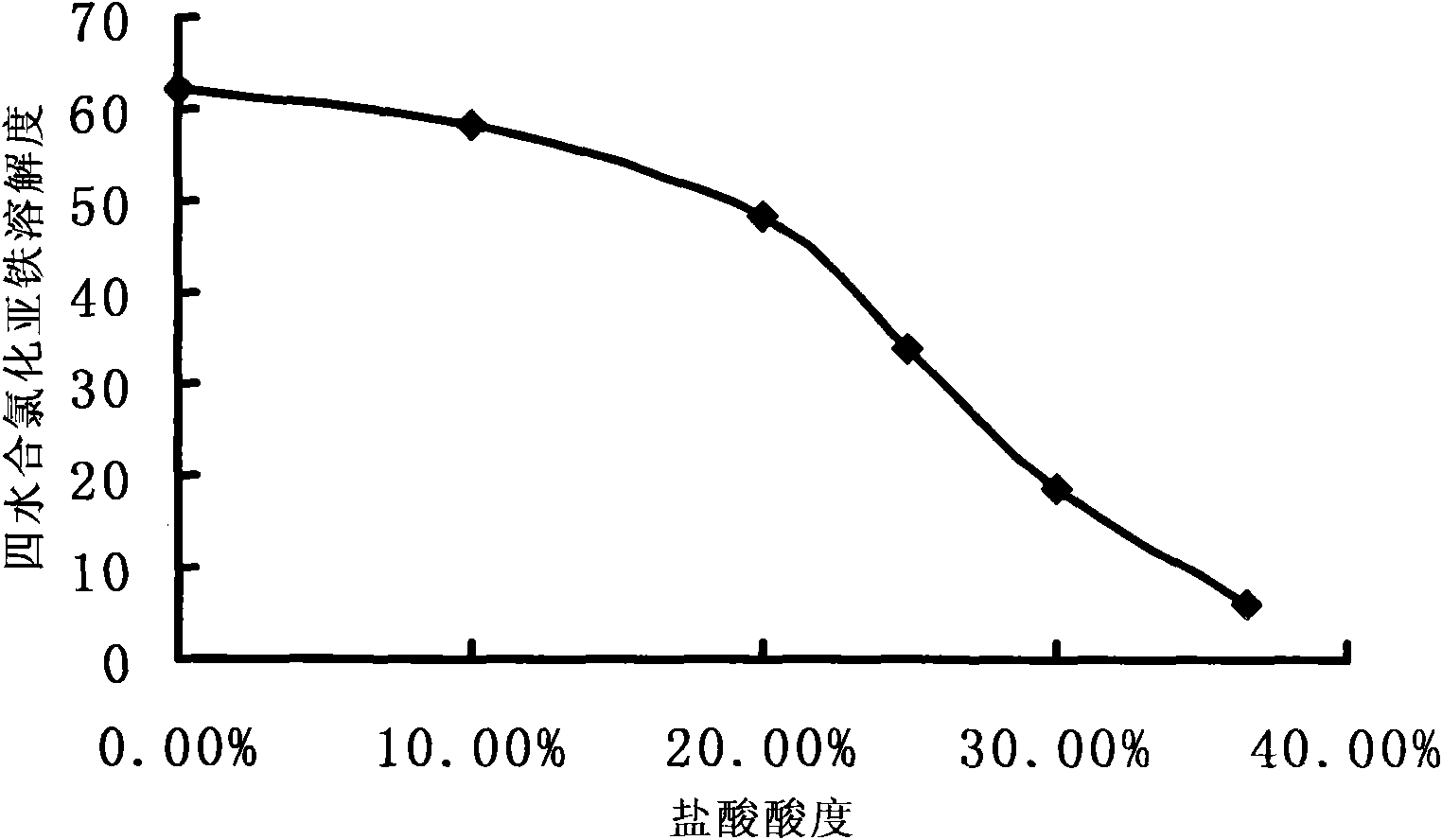New process for recycling pickling waste liquid
A technology of pickling waste liquid and pickling, which is applied in the fields of metallurgical wastewater treatment, iron halide, chemical instruments and methods, etc., can solve the problems of corrosion, poor operating environment, and large consumption of alkali
- Summary
- Abstract
- Description
- Claims
- Application Information
AI Technical Summary
Problems solved by technology
Method used
Image
Examples
Embodiment 1
[0012] Take 40ml of the pickling waste liquid from the pickling section of the steel plant (the pickling waste liquid is taken from a steel plant, and the appearance is a yellow-green clear liquid with a sour taste, [H + ]=9.8mol / L, the total iron content is 154.9g / L, the content of divalent iron ion is 149.1g / L, the acidity of HCl is 12.07%) is added to the three-necked flask to be reacted. Inject continuously stable HCl gas into the pickling waste liquid. The other mouth of the three-necked bottle is connected to a buffer bottle to prevent back suction. After the buffer bottle, use the pickling waste liquid for circular absorption.
[0013] In order to prevent the reaction from being too rapid, HCl gas was introduced slowly and stably while stirring the waste pickling liquid for full absorption. Depending on the aeration rate, about 20 to 60 minutes, yellow-green crystals were continuously precipitated in the waste pickling liquid. HCl gas is continuously fed in and cooled to 1...
Embodiment 2
[0016] Take 40ml of the pickling waste liquid from the pickling section of the steel plant (the pickling waste liquid is taken from a steel plant, and the appearance is a yellow-green clear liquid with a sour taste, [H + ]=9.8mol / L, total iron content is 154.9g / L, of which ferric ion content is 149.1g / L, HCl acidity is 12.07%) added to a three-necked flask for reaction. Inject continuously stable HCl gas into the pickling waste liquid. The other mouth of the three-necked bottle is connected to a buffer bottle to prevent back suction. After the buffer bottle, use the pickling waste liquid for circular absorption.
[0017] In order to prevent the reaction from being too rapid, HCl gas was introduced slowly and stably while stirring the waste pickling liquid for full absorption. Depending on the aeration rate, about 20 to 60 minutes, yellow-green crystals were continuously precipitated in the waste pickling liquid. HCl gas is continuously introduced and cooled to 15°C. Most of the i...
Embodiment 3
[0020] Take 40ml of the pickling waste liquid from the pickling section of the steel plant (the pickling waste liquid is taken from a steel plant, and the appearance is a yellow-green clear liquid with a sour taste, [H + ]=9.8mol / L, total iron content is 154.9g / L, of which ferric ion content is 149.1g / L, HCl acidity is 12.07%) added to a three-necked flask for reaction. Inject continuously stable HCl gas into the pickling waste liquid. The other mouth of the three-necked bottle is connected to a buffer bottle to prevent back suction. After the buffer bottle, use the pickling waste liquid for circular absorption.
[0021] In order to prevent the reaction from being too rapid, HCl gas was introduced slowly and stably while stirring the waste pickling liquid for full absorption. Depending on the aeration rate, about 20 to 60 minutes, yellow-green crystals were continuously precipitated in the waste pickling liquid. HCl gas is continuously fed in and cooled to 15°C. Most of the iron ...
PUM
 Login to View More
Login to View More Abstract
Description
Claims
Application Information
 Login to View More
Login to View More - R&D
- Intellectual Property
- Life Sciences
- Materials
- Tech Scout
- Unparalleled Data Quality
- Higher Quality Content
- 60% Fewer Hallucinations
Browse by: Latest US Patents, China's latest patents, Technical Efficacy Thesaurus, Application Domain, Technology Topic, Popular Technical Reports.
© 2025 PatSnap. All rights reserved.Legal|Privacy policy|Modern Slavery Act Transparency Statement|Sitemap|About US| Contact US: help@patsnap.com

